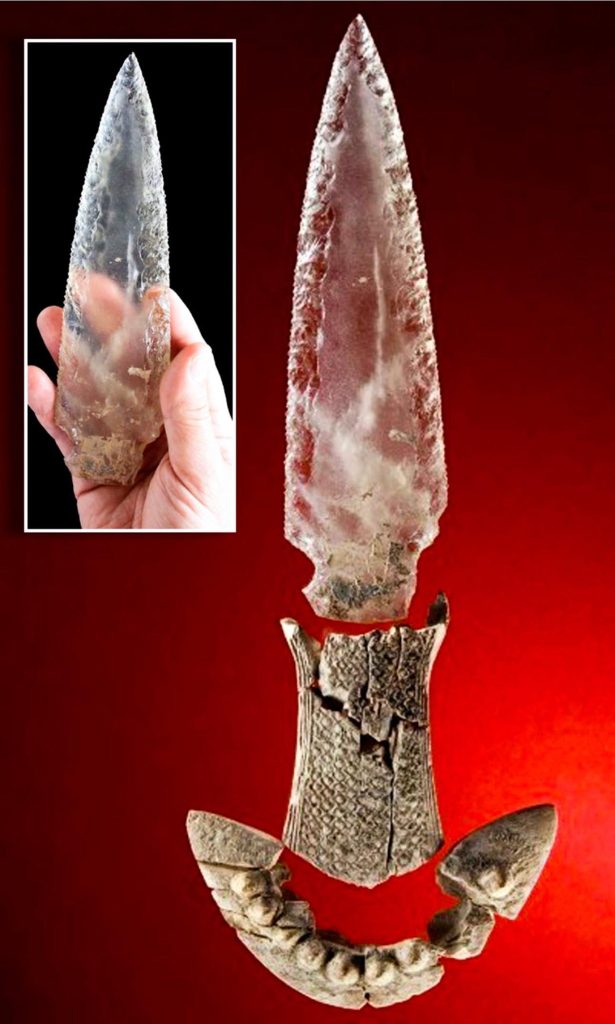In the sun-drenched plains of southwestern Spain, a discovery has emerged that is nothing short of extraordinary—a find that offers a stunning glimpse into the minds and capabilities of prehistoric peoples. Nestled within the Montelirio tholos, a megalithic tomb near Seville, archaeologists uncovered an artifact that defies our expectations of ancient craftsmanship: a beautifully carved crystal dagger, dating back more than 5,000 years to around 3000 BCE. This ancient weapon, forged from rock crystal, not only exemplifies the technical prowess of its makers but also provides insight into the spiritual and cultural values of early European societies. It is a masterpiece of prehistoric engineering and artistry that continues to spark fascination and debate among researchers and history enthusiasts alike.

The Montelirio tholos, excavated thoroughly between 2007 and 2010, is a sprawling burial site measuring approximately 143 feet in length. This megalithic structure, built with precision and care, served as a final resting place for at least 25 individuals. Their skeletal remains were found arranged in a curious circular formation, suggesting deliberate placement in accordance with rituals we have yet to fully understand. Surrounding these human remains were numerous grave goods—most notably the exceptional crystal dagger and 25 arrowheads, all meticulously crafted from the same brilliant material. These items hint at a complex society in which symbolism, ritual, and social hierarchy were deeply intertwined.
The dagger itself, measuring 20 centimeters in length, is a wonder of prehistoric craftsmanship. Hewn from a single piece of transparent crystal, it boasts a sharp blade that, remarkably, still glistens after thousands of years. The handle, made of ivory and engraved with geometric patterns, adds another layer of sophistication. This wasn’t merely a weapon for practical use; it was a ceremonial object, a symbol of power, possibly even a conduit for connecting with the spiritual realm. The level of precision and skill required to create such an object from such a fragile material would have been immense, indicating not only advanced tool use but also a highly developed aesthetic sensibility.
The choice of rock crystal for these artifacts is particularly significant. In the prehistoric world, materials carried symbolic meanings, and rock crystal—rare, luminous, and difficult to source—was likely considered sacred. There are no known crystal quarries near the Montelirio site, suggesting that the raw materials were brought from distant regions. This would have made the dagger and arrowheads immensely valuable, likely reserved for individuals of high status or used in the most important ceremonial contexts. Their presence in a burial tomb implies that the people buried there were of considerable importance and that their send-off into the afterlife involved powerful symbols and possibly magical rites.
Moreover, in many ancient cultures, crystal was believed to possess spiritual properties. It was associated with vitality, purity, and a link to the supernatural. The people who built Montelirio tholos may have believed that such materials could bridge the divide between the living and the dead, the earthly and the divine. The crystal dagger, therefore, may have served not just as a tool or status symbol, but as a powerful talisman intended to guide or protect the deceased in the afterlife. The circular arrangement of the dead, combined with the presence of these unique items, suggests an elaborate cosmology and a belief system centered on ancestral veneration and spiritual transformation.
The broader implications of the Montelirio discoveries are profound. They offer a window into the complexity of social structures, religious beliefs, and technological capabilities in Neolithic Iberia. Far from being simple or primitive, these societies demonstrated an understanding of materials, artistry, and ritual practice that rivaled more well-documented ancient civilizations. The craftsmanship evident in the crystal dagger rivals that seen in more famous ancient cultures, such as the Egyptians or Mesopotamians, and underscores the global nature of early human ingenuity.
In the ongoing effort to decode the past, such findings challenge modern assumptions about prehistoric life. They remind us that human creativity and curiosity are not recent developments but have long been at the heart of our story. As researchers continue to study the artifacts and human remains from Montelirio tholos, they uncover more details about the lives, deaths, and beliefs of people who lived over five millennia ago. These insights enrich our understanding of early European history and contribute to the broader narrative of human civilization.
The crystal dagger of Seville is more than just an ancient relic; it is a symbol of our shared heritage, a bridge between our modern world and the distant past. It invites us to reflect on the incredible skill and imagination of our ancestors and to appreciate the layers of meaning embedded in the objects they left behind. As we gaze upon its shimmering blade, we are reminded of the continuity of human experience—the universal desire to create, to believe, and to connect with forces beyond our understanding. This single artifact, preserved through the ages, tells a story of art, ritual, and identity that continues to resonate in the present day.





